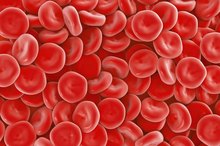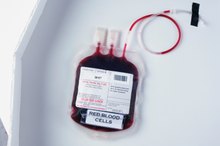Reasons for a Low Red Blood Count of 7.7
Red blood cells make up a portion of blood. A normal red blood count is 13.8 to 17.2 grams per deciliter; women have a lower red blood count, between 12.1 and 15.1gm/dL, according to Medline Plus, a publication of the National Institutes of Health. Lower than normal numbers indicate anemia. A red blood count of 7.7 gm/dL is much lower than normal; physicians may consider doing a blood transfusion if levels drop to 7 gm/dL or less, the University of Medicine and Dentistry of New Jersey states. A lower than normal red blood count can be caused by several medical issues.
Blood Loss
Medical conditions that cause blood loss can cause the red blood count to drop down to levels of 7.7 gm/dL. While small amounts of blood loss, the most common cause:
- the red blood count to drop severely [2](https://www.nhlbi.nih.gov/health-topics/anemia 'inline-reference::National Heart
- Lung
- Blood Institute: What Causes Anemia?')
Heavy menstrual periods are the most common cause of anemia in women of childbearing age, the University of Maryland Medical Center states.
Decreased Red Blood Cell Production
What Is MCHC in a Blood Test?
Learn More
One of the most common causes of decreased red blood cell production and red blood count as low as 7.7 gm/dl is iron deficiency anemia, where low levels of iron decrease the production of red blood cells. Impaired absorption or inadequate intake also decreases iron stores. Low iron levels also occur in pregnancy. Some cancers and chemotherapy and radiation to treat cancer can also decrease red blood cell production and anemia. Some chronic diseases such as chronic inflammatory diseases can also interfere with red blood cell production, the Mayo Clinic says 1. Plastic anemia, which can be congenital or develop later in life, results in an inability to produce red blood cells. Thalassemia, an inherited disease, also causes decreased production.
- One of the most common causes of decreased red blood cell production and red blood count as low as 7.7 gm/dl is iron deficiency anemia, where low levels of iron decrease the production of red blood cells.
Abnormal Red Blood Cell Production
Vitamin B12 deficiency can cause megaloblastic anemia, in which the red blood cells produced are abnormally large. Sickle cell anemia, an inherited disease, causes sickle shaped red blood cells with a short life span, the University of Maryland Medical Center says.
Increased Destruction of Red Blood Cells
What Is High RDW and Low Ferritin?
Learn More
Very low red blood counts can occur when the red blood cells are produced normally but then destroyed. Autoimmune diseases and some medications cause hemolytic anemia.
Related Articles
References
- Mayo Clinic: Anemia
- National Heart, Lung and Blood Institute: What Causes Anemia?
- D'John J, Hutchins M, Januchowski R. Medical management of anemia in the surgical patient. Osteopathic Family Physician. 2016;8(5):28-31.
- Lingohr P, Bensoukehal S, Matthaei H, et al. Value and risk of laparoscopic surgery in hemophiliacs-experiences from a tertiary referral center for hemorrhagic diatheses. Langenbecks Arch Surg. 2014;399(5):609-18. doi:10.1007/s00423-014-1185-7
- Muñoz M, Acheson AG, Auerbach M, et al. International consensus statement on the peri-operative management of anaemia and iron deficiency. Anaesthesia. 2017;72(2):233-247. doi:10.1111/anae.13773
- Partridge, J.; Harari, D.; Gossage, J. et al. Anaemia in the older surgical patient: a review of prevalence, causes, implications and management. J R Soc Med. 2013;106(7): 269-77. DOI: 10.1177/0141076813479580.
Writer Bio
A registered nurse with more than 25 years of experience in oncology, labor/delivery, neonatal intensive care, infertility and ophthalmology, Sharon Perkins has also coauthored and edited numerous health books for the Wiley "Dummies" series. Perkins also has extensive experience working in home health with medically fragile pediatric patients.









